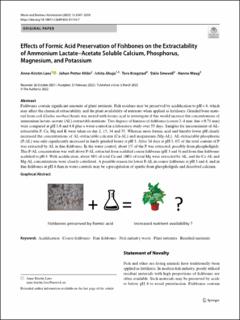| dc.contributor.author | Løes, Anne-Kristin | |
| dc.contributor.author | Ahlin, Johan Petter | |
| dc.contributor.author | Ahuja, Ishita | |
| dc.contributor.author | Krogstad, Tore | |
| dc.contributor.author | Smevoll, Ståle | |
| dc.contributor.author | Waag, Hanne | |
| dc.date.accessioned | 2022-12-23T20:16:37Z | |
| dc.date.available | 2022-12-23T20:16:37Z | |
| dc.date.created | 2022-05-03T12:28:13Z | |
| dc.date.issued | 2022-03-03 | |
| dc.identifier.citation | Waste and Biomass Valorization. 2022, 13 3547-3559. | en_US |
| dc.identifier.issn | 1877-2641 | |
| dc.identifier.uri | https://hdl.handle.net/11250/3039469 | |
| dc.description.abstract | Fishbones contain significant amounts of plant nutrients. Fish residues may be preserved by acidification to pH < 4, which may affect the chemical extractability, and the plant availability of nutrients when applied as fertilisers. Grinded bone material from cod (Gadus morhua) heads was mixed with formic acid to investigate if this would increase the concentrations of ammonium lactate–acetate (AL)-extractable nutrients. Two degrees of fineness of fishbones (coarse 2–4 mm; fine < 0.71 mm) were compared at pH 3.0 and 4.0 plus a water control in a laboratory study over 55 days. Samples for measurement of AL-extractable P, Ca, Mg and K were taken on day 2, 15, 34 and 55. Whereas more formic acid and thereby lower pH clearly increased the concentrations of AL-extractable calcium (Ca-AL) and magnesium (Mg-AL), AL-extractable phosphorus (P-AL) was only significantly increased in finely grinded bones at pH 3. After 34 days at pH 3, 6% of the total content of P was extracted by AL in fine fishbones. In the water control, about 1% of the P was extracted, possibly from phospholipids. This P-AL concentration was well above P-AL extracted from acidified coarse fishbones (pH 3 and 4) and from fine fishbones acidified to pH 4. With acidification, about 30% of total Ca and 100% of total Mg were extracted by AL, and the Ca-AL and Mg-AL concentrations were closely correlated. A possible reason for lower P-AL in coarse fishbones at pH 3 and 4, and in fine fishbones at pH 4 than in water controls may be a precipitation of apatite from phospholipids and dissolved calcium. | en_US |
| dc.language.iso | eng | en_US |
| dc.publisher | Springer Nature | en_US |
| dc.rights | Navngivelse 4.0 Internasjonal | * |
| dc.rights.uri | http://creativecommons.org/licenses/by/4.0/deed.no | * |
| dc.title | Effects of Formic Acid Preservation of Fishbones on the Extractability of Ammonium Lactate–Acetate Soluble Calcium, Phosphorus, Magnesium, and Potassium | en_US |
| dc.title.alternative | Effects of Formic Acid Preservation of Fishbones on the Extractability of Ammonium Lactate–Acetate Soluble Calcium, Phosphorus, Magnesium, and Potassium | en_US |
| dc.type | Peer reviewed | en_US |
| dc.type | Journal article | en_US |
| dc.description.version | publishedVersion | en_US |
| dc.rights.holder | © The Author(s) 2022 | en_US |
| dc.source.pagenumber | 3547-3559 | en_US |
| dc.source.volume | 13 | en_US |
| dc.source.journal | Waste and Biomass Valorization | en_US |
| dc.identifier.doi | 10.1007/s12649-022-01744-7 | |
| dc.identifier.cristin | 2020931 | |
| cristin.ispublished | true | |
| cristin.fulltext | original | |
| cristin.qualitycode | 1 | |

